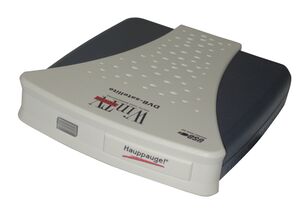Hauppauge WinTV-NOVA-S USB: Difference between revisions
No edit summary |
m (Added category: DVB-S USB Devices) |
||
| (16 intermediate revisions by 3 users not shown) | |||
| Line 1: | Line 1: | ||
[[Image:Hauppauge WinTV-NOVA-S USB.jpg|thumb|Hauppauge WinTV-NOVA-S USB]] |
|||
| ⚫ | |||
A [[DVB-S]] [[DVB-S USB Devices|USB 1.1 device]] designed by [[TechnoTrend]] and sold by [[Hauppauge]]. |
|||
It is supported under Linux. |
|||
As decoder a [[TDA8083]] or a [[STV0299]] is used. |
|||
==Overview/Features== |
|||
Due to the limited [[USB1.1]] [[Bus Bandwidth]] of about 12MBit only selected [[PID]]s can get transferred over the USB Bus to the Host. Some High-Bandwidth [[Transponder]]s don't work. |
|||
This device is a rebadge of the DVB-S member of TechnoTrend's TT-PCline USB family of devices, which were USB1.1 based and of the, so called, "budget" category. |
|||
| ⚫ | |||
| ⚫ | |||
Due to the limited [[Bus Bandwidth|bus bandwidth]] provided by [[Universal Serial Bus|USB 1.1]], of approximately 12Mbps, only selected [[PID]]s can be transferred over USB to the host system. Consequently, some high bandwidth [[Transponder|transponders]] won't work, and [[HDTV]] reception is not possible. |
|||
A similiar [[DVB-T]] device is available, the [[WinTV-NOVA-T USB]]. |
|||
===Components Used=== |
|||
* Either the [[Philips]] [[Philips TDA8083|TDA8083]] or [[STMicroelectronics]] [[STMicroelectronics STV0299|STV0299]] [[Demodulator|demodulator]] is used |
|||
* a [[Texas Instruments]] [[DSP]] (USB bridge) |
|||
===Identification=== |
|||
output of ''lsusb -v'': |
|||
===Hauppauge/TT Nova-USB-s budget=== |
|||
(stv0299/ALPS BSRU6(tsa5059) OR tda8083/Grundig 29504-451(tsa5522)) |
|||
features: partialts |
|||
card driver: ttusb-budget |
|||
interface: USB1.1 |
|||
USB device id: 0b48:1003 |
|||
frontend possibility 1: |
|||
tin box: ALPS BSRU6 |
|||
frontend driver: stv0299 |
|||
demodulator location: tin box |
|||
demodulator: ST stv0299b @0x68 |
|||
PLL: Philips tsa5059 @0x61 |
|||
frontend possibility 2: |
|||
tin box: Grundig 29504-451 |
|||
frontend driver: tda8083 |
|||
demodulator location: tin box |
|||
demodulator: Philips tda8083 @0x68 |
|||
PLL: Philips tsa5522 @0x61 |
|||
Notes: This device has only one frontend - but there are two possibilities |
|||
Although the hardware is capable of delivering the entire transport stream, the bandwidth of the USB bus prevents it |
|||
==Making it Work== |
|||
===Firmware=== |
|||
| ⚫ | |||
===Drivers=== |
|||
The following drivers are needed for these devices: |
|||
- stv0299.ko |
|||
- tda8083.ko |
|||
- dvb-ttusb-budget.ko |
|||
==External Links== |
|||
[[Category:DVB-S USB Devices]] |
|||
Latest revision as of 02:33, 4 May 2009
A DVB-S USB 1.1 device designed by TechnoTrend and sold by Hauppauge.
It is supported under Linux.
Overview/Features
This device is a rebadge of the DVB-S member of TechnoTrend's TT-PCline USB family of devices, which were USB1.1 based and of the, so called, "budget" category.
It uses a Texas Instruments DSP that remultiplexes the stream into a TechnoTrend-proprietary USB packet format and sends it as Isochronous USB Stream over the bus.
Due to the limited bus bandwidth provided by USB 1.1, of approximately 12Mbps, only selected PIDs can be transferred over USB to the host system. Consequently, some high bandwidth transponders won't work, and HDTV reception is not possible.
Components Used
- Either the Philips TDA8083 or STMicroelectronics STV0299 demodulator is used
- a Texas Instruments DSP (USB bridge)
Identification
output of lsusb -v:
Hauppauge/TT Nova-USB-s budget
(stv0299/ALPS BSRU6(tsa5059) OR tda8083/Grundig 29504-451(tsa5522))
features: partialts
card driver: ttusb-budget
interface: USB1.1
USB device id: 0b48:1003
frontend possibility 1:
tin box: ALPS BSRU6
frontend driver: stv0299
demodulator location: tin box
demodulator: ST stv0299b @0x68
PLL: Philips tsa5059 @0x61
frontend possibility 2:
tin box: Grundig 29504-451
frontend driver: tda8083
demodulator location: tin box
demodulator: Philips tda8083 @0x68
PLL: Philips tsa5522 @0x61
Notes: This device has only one frontend - but there are two possibilities
Although the hardware is capable of delivering the entire transport stream, the bandwidth of the USB bus prevents it
Making it Work
Firmware
Requires a Firmware that needs to get peeled out of the Windows Driver.
Drivers
The following drivers are needed for these devices:
- stv0299.ko - tda8083.ko - dvb-ttusb-budget.ko
